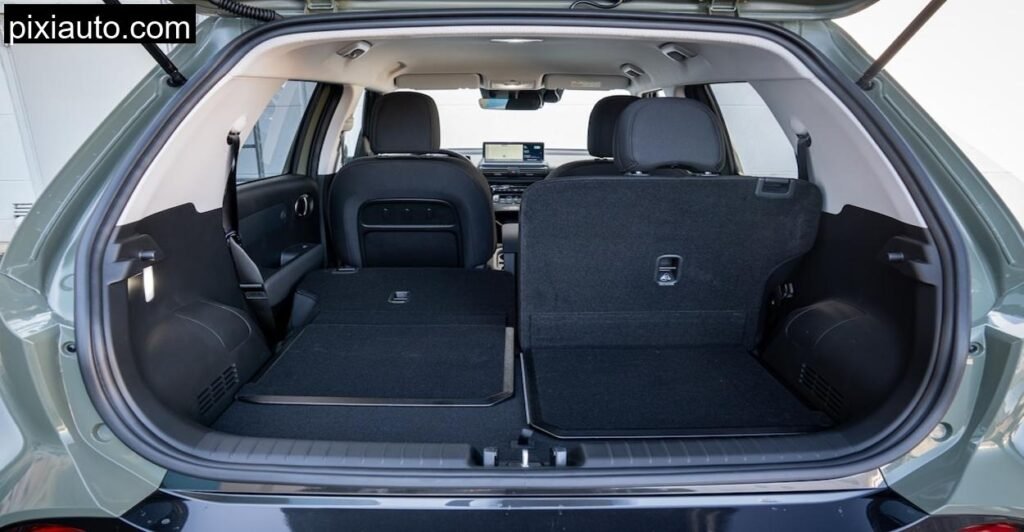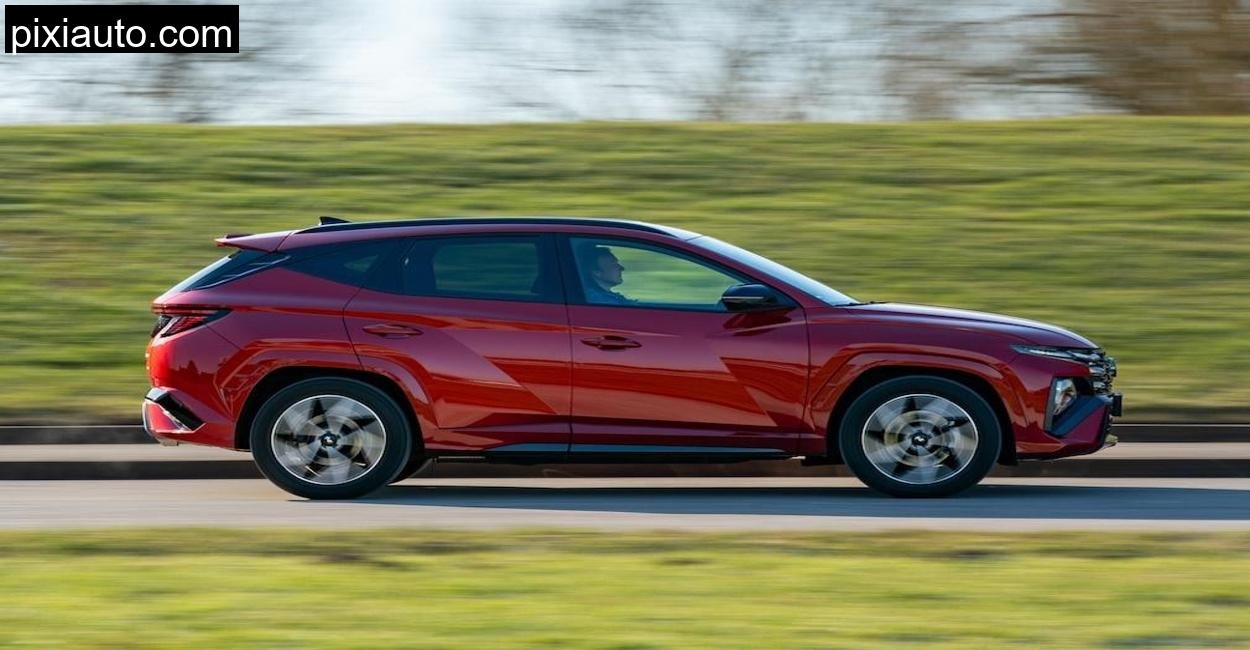It was a quiet, breezy morning up in Weper. The sky wore a calm blue, with the woods rustling gently, as if in approval of the little electric car that had just arrived. A narrow road weaves through this lesser, known ridge in Lower Saxony, a perfect setting to test the kind of car that isn’t made for racetracks, but for the real world, tight village lanes, patchy surfaces, spontaneous parking spots, and the ever, demanding urban rhythm. That car was the new Hyundai Inster, the electric mini crossover from Korea.
What VW keeps teasing with €20,000 EV promises, Hyundai has simply gone ahead and built. The Inster is not a concept, it’s not vaporware. It’s real, it’s affordable, and, at least on paper, it’s pretty darn capable. But spec sheets never tell the full story. That’s why I brought it up here, to see what this quirky compact is really made of in a real, world environment.
First Impressions: Funky Looks, Smart Space
I have to admit, I wasn’t fully prepared for how much presence this 3.83, meter, long car had in person. It’s shaped like a futuristic micro, van, almost toy, like at first glance. Yet it didn’t feel toy, like once I slid behind the wheel. You step in rather than drop in, which is refreshing. The upright seating and high roofline mean it feels far roomier inside than its length would suggest. Sure, it’s only 1.61 meters wide, so yes, you and your front passenger might occasionally play shoulder hockey. But overall, it feels like a compact box full of cleverness.
The materials are honest. Not luxury, but not chintzy. The dashboard is dominated by twin 10.3, inch displays, one for your instruments, one for infotainment. It’s a clean layout, broken up by an old, school panel of physical buttons. Hyundai, thankfully, hasn’t thrown ergonomics to the wind in pursuit of screens.
In Weper’s steep and winding elevation shifts, I needed to focus on the road, not scroll through five menus just to warm my seat. Speaking of which, even at just 12 degrees outside, the seat heater kicked in fast and hot. Instant comfort in a car this small is a rare treat.
City and Country in a Single Drive
The Inster’s powertrain isn’t going to peel your face off. At 85 kW (115 hp) and 147 Nm, this isn’t a numbers game. But Hyundai plays the usability game better than most. It gets from 0, 50 km/h in 3.9 seconds, which in the stop, and, go urban dance is more important than 0, 100 sprints. It actually did the 0, 100 km/h dash in a respectable 10.2 seconds when I tested it on an open patch near the Weper wind turbines.
Where it truly shined was on the undulating switchbacks. Despite the short 2.58, meter wheelbase, the Inster was planted. The ride was surprisingly composed. Hyundai has nailed the damping, it absorbs imperfections with confidence. Only on very abrupt edges did I feel a thump. And though the steering is a bit on the light and indirect side, it never left me guessing.
It took corners with an eagerness I didn’t expect. You could tell the low, mounted battery and overall balanced 58/42 weight distribution help. Occasionally, I could hear the inside front wheel chirp a little in sharp corners, but nothing felt unsettling. The Inster is no sports car, but it isn’t a couch either.
Everyday Practicality: Clever Is the Word

Living with the Inster for the day brought out all its little clever features. That’s where this car earns its stripes. For example, the rear seat slides, how many EVs under €30,000 can say that? And the front seats (driver included, in Trend trim and above) fold completely flat, letting me toss a mountain bike frame in the back without disassembling half the cabin.
The boot isn’t huge at first glance, 238 liters, but extend the sliding rear bench, fold everything down, and you’re looking at a cavernous 1059 liters. Hyundai even designed a double floor in the rear, giving me a flat load surface to lie on. Yes, you can actually sleep in this car. I tested it by tossing in a mat and stretching out with my legs slightly bent. Not ideal for two, but for one tired traveler? It works.
A couple of usability snags did pop up. That load lip is unnecessarily high at 78 cm, which meant hoisting heavy items required a bit of muscle. And the tailgate doesn’t open that high, at 1.85 meters clearance underneath, I did bump my head once. But the cleverness outweighs the quirks.
Charging and Range: Not Fast, but Fair
Hyundai quotes a WLTP range of 360 km for the 49 kWh battery in the Inster Prime. My mixed driving loop from city to country to fast autobahn stretches came in at 286 km, which isn’t bad at all given the inclines and enthusiastic driving. On the A7 segment where I cruised at 130 km/h, the range fell to about 222 km, again, respectable.
Charging was easy. With 11 kW AC or up to 85 kW DC, I topped up from 10, 80% in just about 31 minutes at a highway charger outside Einbeck. The charging port is up front, so you don’t have to worry which side you’re parking on. The heat pump also did its job efficiently, standard on the Prime, optional on others. On a chilly morning in Weper, the battery pre, conditioning made a noticeable difference.
Tech and Comfort: Simple, Not Dumb
The interface is what I’d call intelligently basic. Yes, Apple CarPlay and Android Auto need a cable. No, there’s no natural voice assistant, though you can say “I’m cold” or “I’m hot” and it will adjust temperature accordingly. The navigation system was accurate and responsive, and the climate panel is thankfully not buried in a touchscreen menu.
The Prime trim also brings a surprising amount of kit. Lane, keeping assist worked well on our country stretches, blind spot monitors lit up intuitively, and the 360, degree camera proved invaluable when parallel parking on the narrow Weper village road. There’s no adaptive suspension or flashy matrix LEDs here. But what’s included, works.
Technical Specifications
For data reliability, we extract all technical specifications from Hyundai’s official online presence.
| Specification | Value |
| Motor Type | Synchronous Electric |
| Power (Max) | 85 kW (115 hp) |
| Torque | 147 Nm |
| Drive | Front, wheel drive |
| Gearbox | Single, speed automatic |
| Battery Capacity | 49 kWh |
| WLTP Range | 360 km |
| Real, world Range (tested) | 286 km |
| Acceleration 0, 100 km/h | 10.2 seconds |
| Top Speed | 150 km/h |
| Charging (AC/DC) | 11 kW / 85 kW |
| Charging Time (10, 80%, DC) | ~30 minutes |
| Consumption (WLTP/Test) | 15.1 / 19.8 kWh/100 km |
| Boot Space | 238 , 1059 liters |
| Length x Width x Height | 3825 x 1610 x 1575 mm |
| Wheelbase | 2580 mm |
| Weight | 1390 kg |
| Price (Base/Tested) | €25,400 / €30,100 |
Conclusion: It Doesn’t Just Try, It Delivers
The Hyundai Inster is not a car you dream about. It’s not here to make you feel like Batman. But in a world of bloated EVs and broken promises, it’s refreshing to drive something that just works. It has character. It has practicality. It’s priced to be attainable. And it’s more fun than I expected on country roads.
Driving through Weper with the leaves brushing past, a windmill turning in the background, I kept thinking: this is the kind of car that actually moves people, not just physically, but philosophically. It proves that being small doesn’t mean being compromised. It proves that simple doesn’t mean boring.
How big is the Hyundai Inster inside?
It’s surprisingly roomy for a 3.83 m car. Four adults fit comfortably, and the boot can expand up to 1059 liters thanks to sliding rear seats and foldable front seatbacks.
What is the real, world range of the Hyundai Inster?
In our mixed test loop, it delivered 286 km, and about 222 km at constant 130 km/h.
Can you sleep in Hyundai Inster?
You can. With the front seats folded and the rear bench slid forward, a solo traveler can comfortably lie down with a mat.



Leave a Comment